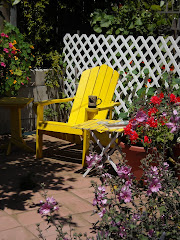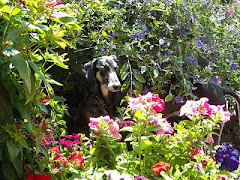Calhoun’s Can(n)ons, The Bay News, Tolosa Press, SLO, Ca for Jan 31, 08
Going Native
Show me a day when the world wasn’t new.
Sister Barbara Hance (1928-1993)
In a recent Tribune story, it was announced that the Morro Coast Audubon Society was awarded a $1.1 million grant from the state’s Coastal Conservancy to add additional acreage to the Los Osos Sweet Springs Preserve. Smiles all around until the subject of “restoration” came up, with the operative word being “restore,” as in, “remove all nonnative vegetation at the Sweet Springs.”
Translation? Kill the Eucalyptus.
Thus the battle once again will be joined between the True Believing Native Purists and what might be called Conservative Pragmatists, both engaged in an epic battle for the soul of California, a biological war of skirmishes that often breaks along very curious lines and includes strange bedfellows and odd assumptions about both past and future, all while wandering in and out of the realm of meaning found in Alice in Wonderland’s Through the Looking Glass, “When I use a word,” Humpty Dumpty said, in rather a scornful tone, “It means just what I choose it to mean – neither more nor less.”
Consider the words “Native Plants.” First question required: Who decides? And Which era? Pre-human? Post-human, but which migration? Or should we restrict “native” to mean post-human but pre-Spanish? Post Spanish, but pre-Yankee? Which Yankees, those arriving before or after 1840? Why 1840? Why not 1867? Or 1900?
And what constitutes “California Natural?” The landscape prior to human arrival was a landscape far different than anything we see today. Not only did early humans have a profound impact on the landscape via use of fire to modify the areas they occupied, but huge climate changes during those long epochs also changed the natural selection of what plants survived long enough to be considered “Native” by modern Purists, who now claim the right to decide exactly what constitutes a “native plant.”
Muddling things even further is the fact that trying to restore some parts of California to a “natural, native” state is more an ideal dream of returning to an arbitrary Eden than it is a practical reality, because the old Devil that resides in the details arrives fully loaded down with annoying problems.
For example, a friend of mine sent a letter to the editor regarding this story that noted, in part, “Some pruning of old eucalyptus trees could be done, but the trees are a big part of the beauty and quiet of the preserve; and they provide habitat not only for monarch butterflies and birds of prey, but for many other birds as well. I have seen nesting owls there, for instance. They also add much needed environmental temperature control for the pond where turtles can be found basking on boards. It is sad that conservation purists (zealots) rush to rid California of all ‘non-native’ plants, including these spectacular trees, when eucalyptus trees have such a rich 19th century history in California.”
That neatly encapsulates some of the argument. At Sweet Springs, what shall take precedence? Aesthetics, history, a butterfly’s choice of a winter’s rest stop, or an owl’s sleeping arrangements?
Add to that mix the sad fact that we have a bad record of understanding whether something will break left, break right or simply break bad. In short, we are usually not able to see far enough into the future to see that perhaps sacrificing a butterfly’s refuge now in order to create a native plant refuge later may not be the wisest course. Nor do we often fully understand the quirky trade-offs needed to even attempt to restore a habitat. And while we’re attempting to factor in the impacts of urbanization, changing micro-climates, and now the changing macro-climate, too often we see too late that our choices were the wrong ones. Or, more dismaying, that Nature on her own has made an entirely different choice and left us standing in the dust, useless shovel and chainsaw in hand, an arboreal version of a Brooklyn raspberry echoing in our foolish ears.
Which, of course, is one reason to “make haste slowly,” and “above all, do no harm,” when it comes to saving and/or restoring our sacred wild spaces. For that reason, I hope that when it comes to the Los Osos Sweet Springs Preserve, humble caution rather than pre-selected ideology will prevail.
Subscribe to:
Post Comments (Atom)












6 comments:
Great article Ann, Kudos!
Well, I hope they just leave Sweet Springs alone.
The "What is nature?" question is sure complicated, I've even heard from well intentioned folks that the earth would be better off if all the human infestation would just leave.
Who would pull up all those non-native invasive plants then?
And since the earth is getting warmer on our account, and we don't seem to be willing to stop it, what happens to the native plants that cant survive a hotter/dryer climate?
Maybe we should be using G.E. to save them?
A great book on this subject (my tongue in cheek comments aside) is "The Botany of Desire" by M. Polan.
Discover Channel last year or so did a series using CGC animation on the various mammals that existed between the demise of the dinosaurs and the appearance of humans. What was so wonderful and sad and startling was to be reminded of the ENORMOUS numbers of utterly WIERD and WONDERFUL animals that were here and are now long, long gone. Somehow, in the shorthand of my mind, I think: Dinosaurs, poof! pronghorned antelope and zebras, forgetting the gazillions of years just filled with all sorts of other amazing creatures unlike anything seen on earth today, all filling their particular niches for their particular time, all long since turned to petrified stone. I'm sure we may join those bones as well. Just another biological variant in a rich mix. Earth will abide. We may not.
Here, the answer is pretty simple.
Things changed rapidly when people started intentionally importing non-native species in significant numbers.
If some accidentally tagged along, any they weren't adapted, they would die.
Eucalyptus trees don't meet that test. And even if they did, they are dangerous because their roots are shallow. They can fall and kill people, and too often do.
As always, a beautifully written blog. On an interesting but utterly intractable topic. Boy, you really like to dwell on the tough ones don't you? Like you I am beyond amazed at the capacity of nature to create - both organic forms and inorganic formations. Although I sometimes wonder whether we aren't deluding ourselves when we draw a distinction between the two. I doubt whether creative force pays much attention to such distinctions. In the vastness of eternity it is all a blank canvas and anything goes. The diversity of lifeforms you mention in your blog remind me of Alan Watt's take on the earth. He said it was a fruiting body. The earth's very purpose is to fruit life. From our egocentric perspective it is 'peopling'. But I think that a somewhat narrow perspective given the huge diversity of life forever re-creating itself on this orb. The macro-organisms we know about are certainly wildly entertaining. But they pale compared to the oddities found in micro-organisms. That's where it gets really really bizarre.
> I'm sure we may join those bones as well. Just another biological variant in a rich mix. Earth will abide. We may not.
I find some small comfort in that. Given our propensity for blundering and screwing things up I find comfort in knowing we are part of something so much bigger than us that there are inherent limits to the damage we can do. The earth will just keep fruiting and fruiting for nearly - read: effectively - forever. I can't wait to see what else it brews.
No Rick, not simple.
The natural world that we live in is complex, almost beyond understanding.
In fact, almost every endeavor and science you can name seeks to understand the natural world in an organized fashion.
That is the basis of human nature.
We seek to shape our world in a facsimile of our dreams, to categorize and enumerate to label what we think we know.
The natural word couldn't care less.
It's quite possible that those eucalyptus are changing in their new environment to fill the niche of our desire, and thereby filling a necessary link.
let them be.
wonderful new book for you'all: (can't find the darned thing) but it's called something like: The Earth After We're Gone. Author carefully documented the various changes that would start taking place if we all immediately disappeared tomorrow. Very interesting. History Channel did a special baed on the same topic, with CGC recrations. Also very interesting.
A fruiting body. Ah, yes, fecund Mother Earth, beautiful Gaia, Persephone returning from the dark every spring. I find that very comforting indeed.
Post a Comment